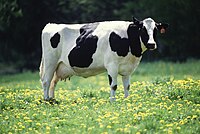
Photo from wikipedia
Introduction Theoretical and modelling approaches were undertaken on Nigerian livestock industry to estimate financial losses due to African animal trypanosomosis. Methods Surveys were conducted between March 2018 and February 2019… Click to show full abstract
Introduction Theoretical and modelling approaches were undertaken on Nigerian livestock industry to estimate financial losses due to African animal trypanosomosis. Methods Surveys were conducted between March 2018 and February 2019 to include focus group interactions, in-depth household engagements concerning livestock practices in relation to AAT. Financial losses estimation on livestock were targeted to provide ways to regain cost and maximize household livelihoods. Mathematical equation was developed to project the effects of intervention strategies. Important variables such as mean AAT prevalence, incidence rate, birth rate, morbidity and mortality were estimated and inserted in the model. Results Mean total income per capita was US$ 1.31 / person / day among livestock producers in Nigeria. A total of US$ 518. 9 million were estimated from direct losses, while US$ 58.8 million as indirect losses. Annual estimated losses to AAT from cattle, sheep, goat and pigs in Nigeria is US$ 577.7 million. This is equivalent to 207.98 billion Nigerian naira and represents 6.93% of annual livestock GDP in the country. This could increase to 85% in the next 50 years if there are no proper control interventions. Control efforts could reduce the losses to US$ 16.7 million at the rate of 0.2% during the same period. Discussions AAT has severe socioeconomic impact on producer’s livelihood and urgent improved control intervention strategies should be instituted to reduce the losses attributed to the disease.
Journal Title: Tropical Animal Health and Production
Year Published: 2021
Link to full text (if available)
Share on Social Media: Sign Up to like & get
recommendations!